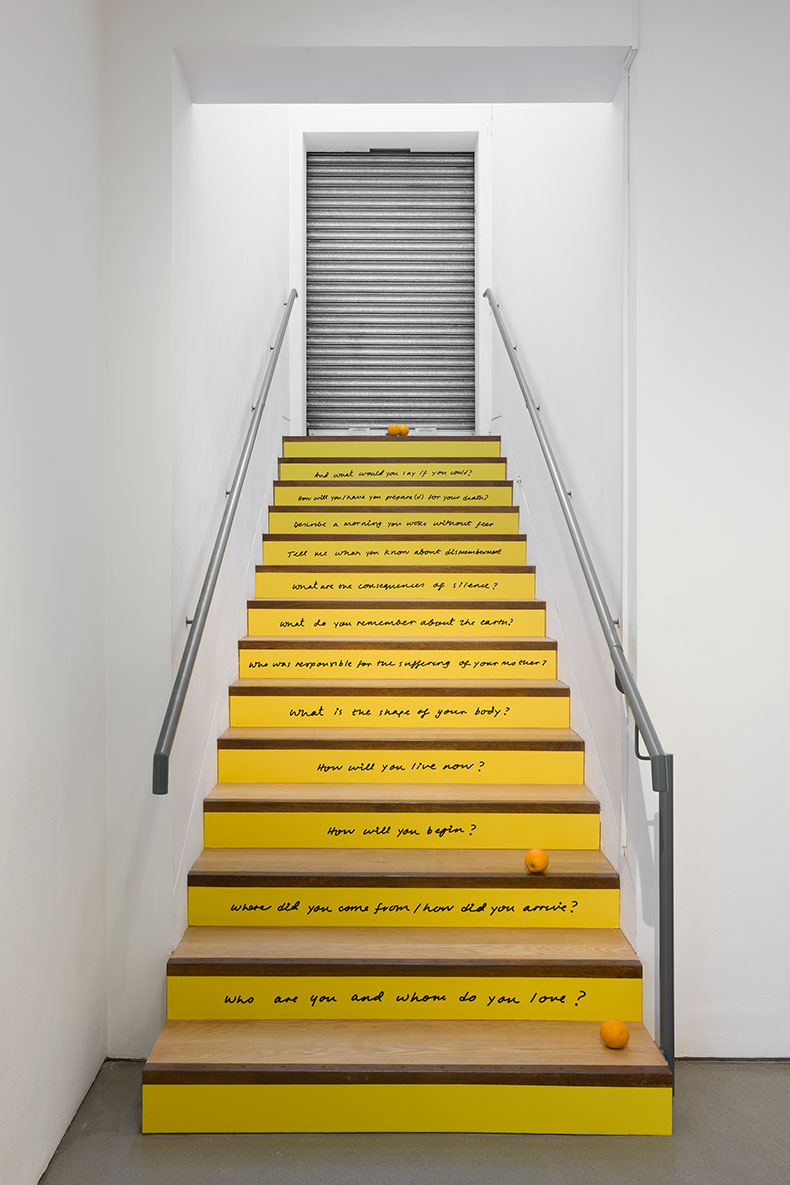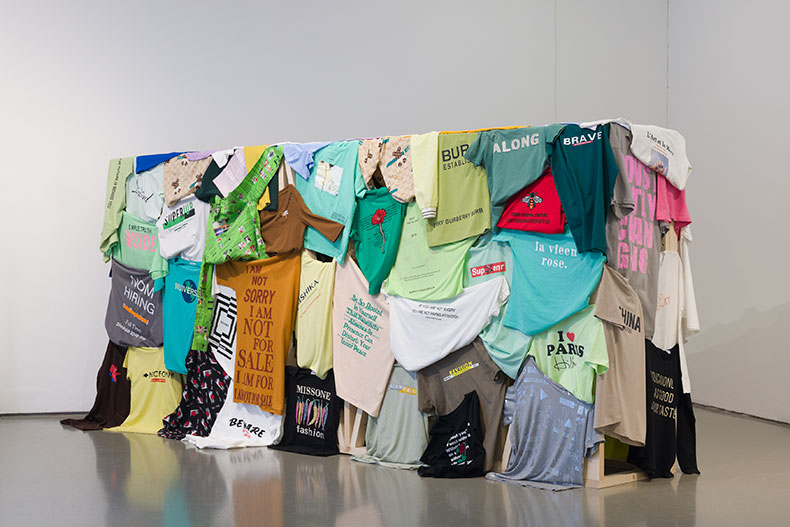At the current exhibition at the Henry Moore Institute, words are coming at you from all angles. They’re dangling vertically from the ceiling in the form of wooden letters, as with Little Thieves by Tim Etchells (2023); they’re heaped on the ground in Floor with All Existing Words (2005–23) by Mark Manders, which presents us with a pile of newspapers containing every word in the English language, all jumbled into a multi-volume word salad. Twelve Questions (2023) by Bhanu Kapil has language climbing the stairs and Say Parsley (2004–23), a sound installation by Caroline Bergvall and Ciarán Ó Meachair, has it coming out of the speakers, mistranslating between text and voice, Irish and English. Even before you even get into the building, spread across its granite exterior facade is Word Fishing (2023), a gigantic, specially commissioned visual poem by Anthony (Vahni) Capildeo.
Installation view of Twelve Questions (2001/23) by Bhanu Kapil at the Henry Moore Institute, Leeds in 2023. Photo: Rob Harris

The show is ‘The Weight of Words’, an immersive, multimedia babel designed to explore the ‘third space’ between two of the oldest art forms, poetry and sculpture. Language is everywhere, but it assumes some strange new forms, coming to life in surprising ways. Parviz Tanavoli’s Standing Heech (2007) is a Farsi symbol meaning ‘nothing’, yet it becomes imbued with a character and agency all its own in this sculpted iteration. Its tensile, snaking form stares at you unnervingly from its ‘double-eyed H’, like a creature crouched waiting to pounce. Good Vibrations by Emma Hart (2023) – a ceramic wall installation looking at first like a row of colourful, wonky archery targets – could be read as a series of concentric Os, growing steadily louder. But equally, perhaps they could be the open mouths producing that sound. Once you realise that there are 13 of them – the number of witches in a coven – the work starts to resonate with even more possible sounds and meanings. Is it the collective howl of a witchy spell-casting, taking us back full-circle to the idea of the target, and the persecution of women’s speech? It’s a cacophony of letter, image, word and object, all noisily talking across one another.
The title of the show gestures towards language as a solid, sculptural thing and also towards its political heft: it’s an exploration of the force of language in an unstable and fraught world. Weighty themes, indeed, yet some of the strongest works here are playful rather than portentous. Incomplete Poem (hedge) (2023) by Shanzhai Lyric is an assortment of bootleg T-shirts slung over a wooden frame, bearing knock-off branding: ‘Nuiversal’, ‘Colvin Klein’, as well as some more inexplicable slogans: ‘“punch me intheface”: I need to feel alive’. The result is a sort of found poetry that gets funnier the longer you stare at it. But it is also a commentary on the tangled fabric of language in the era of global capital in which English has itself sprouted many bootleg variants. The idea of language in ceaseless motion is also at the heart of Shilpa Gupta’s Words Come from Ears (2018), which uses an old-style railway station flap board to create a poem that needs to be watched as much as read. It’s a durational experience, reminiscent of waiting patiently for a platform alteration announcement, giving us one phrase, then another, often full of mistakes. ‘DOES THE TONGUE LITSEN TO THE SOUND OF WRODS?’ it asks, before pausing and correcting itself, but in the process generating more glitches.
Installation view of ‘The Weight of Words’ at the Henry Moore Institute, Leeds, showing Good Vibrations (2023) by Emma Hart and Dark Water, Burning World: 148 Moons and Counting by Issam Kourbaj… (2016). Photo: Rob Harris

Not all of the work is text-based. With its tiny flotilla of boats fashioned from bicycle mudguards, Dark Water, Burning World: 148 Moons and Counting… (2016) by Issam Kourbaj, straggles across the expanse of the gallery floor (a new boat is added for each month that has passed since the Arab Spring). The vulnerability of these tiny makeshift craft, each carrying a fragile cargo of spent matches, speaks for itself. But while Kourbaj’s installation itself is wordless, it has been created in exchange with the poet Ruth Padel, whose work ‘Lesbos’ was a response to witnessing the migrant crisis first hand. Padel’s poem was later renamed to match the title of Kourbaj’s sculpture piece, suggesting a kind of synergy between text and sculpture – two halves of the same work, perhaps.
Meanwhile, looming over Kourbaj’s fragile boats is the show’s weightiest exhibit, Doris Salcedo’s untitled structure (2008), made of interlocking bits of old wooden furniture, filled with half a ton of solid concrete. It’s a response, according to the exhibition catalogue, not only to the civil war in the artist’s native Columbia, but also to the exile poetry of French writer Paul Celan, although it seems to repel any attempt to read it. No matter how many times you wander around it, it always appears to present its back to the viewer. The sheer mute hulk of the work seems a rebuttal of language per se, although perhaps it’s about the unspeakable – the gaps in meaning and places where language can’t reach, or words are too heavy to be uttered. We seem to be suspended in the space between word and object — as with so many other moments in this small but captivating show – unsure of which language is being spoken.
‘The Weight of Words’ is at the Henry Moore Institute, Leeds until 26 November.



